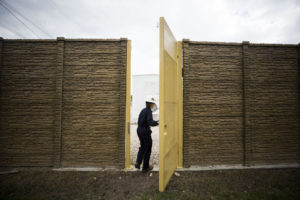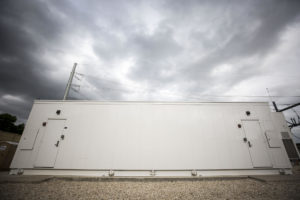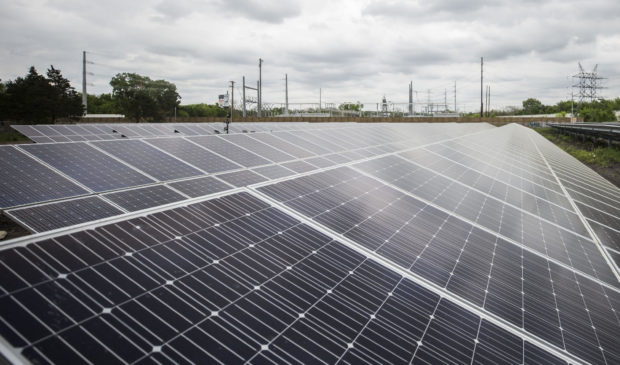Community solar farm and batteries test power of Austin’s electric grid
Wednesday, April 11, 2018 by
Mose Buchele, KUT One of the remarkable things about the La Loma community solar farm is where it’s located. Just east of Airport Boulevard, and a short drive to downtown, it’s the type of place you’d expect to see new homes going up.
“There’s a lot of reason why this parcel really couldn’t have been used for something like housing or other redevelopment,” explained Danielle Murray, manager of solar energy services at Austin Energy, while walking along rows of solar panels.
“There’s a railroad to our south that has freight traffic on it, a water channel down the middle of the site, flood plain issues, protected trees. We’re in the flight path, as you can hear some of the overhead noise.”
Instead, these 16 acres hold enough panels to power 440 households. It’s a part of Austin Energy’s long-standing effort to promote solar. But it’s also part of a unique experiment that could help utilities store more electricity in the future.
For years, Austin Energy has subsidized residential rooftop panels. But those programs give rebates to homeowners, who tend to be wealthier, not renters or people who don’t make much money.
Austin Energy is pitching La Loma as a kind of democratization of solar. A share of the electricity from there is sold at a discount to consumers who couldn’t normally afford it.
“We’re a municipal utility; we’re here to serve our constituents,” said Murray. “If they believe that renewable energy is important and that we should be doing more of it, we’re going to try and do that with and for our customers.”
But projects like this may also serve the utility’s interests. That’s because when people put solar panels on their houses it lets them generate their own power instead of buying from the utility.
“Utilities are worried about a death spiral,” explained Dan Cohan, a professor of civil engineering at Rice University.
“The concern to them is that as they start to lose some customers, then their fixed cost gets divided over fewer and fewer customers; that drives up the cost and then in turn that makes it even more attractive for more people to defect from the grid.”
Big projects like La Loma might be a way for utilities to keep to selling power to customers, while also going solar. In the case of Austin, where the city wants 55 percent of the energy it uses to be renewable by 2025, these projects become even more important.
Solar Plus Storage
But there’s even more happening here than community solar. It’s happening behind a big walled-off section of the lot that buzzes with electricity as you approach.

This is the Kingsbury Substation where Austin Energy has built a giant rechargeable battery with financial help from the state of Texas and the U.S. Department of Energy.
It is in a 46-foot-long white container “essentially the size of the back of an 18-wheeler,” explains Austin Energy’s Lisa Martin, program manager of advanced technologies for the utility.
It’s charged by the solar power generated here, storing enough electricity to power around 300 homes for up to two hours. And it’s one of a few batteries the city’s put around the east side to test what energy storage might mean for the future of the electric grid.
As Martin puts it, they want to figure out “what’s the best way to pair solar with storage and maximize the value.”
She said one way batteries help is by smoothing out the intermittency of renewable energy, a source that is usually only available when the wind blows or the sun shines. With batteries, you can use power from the sun at night.
There are also financial benefits.
“We might charge the battery when prices are low and then discharge it when prices are high,” explains Martin.
The Promise and Perils of Battery Storage
Because of its ability to capture renewable energy and deploy it later, battery storage is sometimes pitched as the key to decarbonization of the grid. But Martin thinks that will be a long time coming.
“If we only relied on intermittent renewable energy and battery storage pairings, we also have to make sure that the rest of the reliability of the grid is maintained,” she said.
To understand the challenge of maintaining grid reliability, it might help to think of electricity as water.

“It’s a little like building a dam,” said Michael Webber, deputy director of the Energy Institute at the University of Texas. Some of his students are studying the Austin Energy project.
“You kind of want to keep the dam empty so that when it rains you can catch the water, except you kind of want the dam to be full, so that when it doesn’t rain you have water available. Same thing with the battery.”
In the short term, Cohan doesn’t think large-scale battery storage will be a necessary part of including more wind and solar on the grid.
“Right now (energy produced in Texas is) 18 percent wind and just 1 percent solar – so we’re doing just fine without a lot of battery storage.”
But, he said, as renewable energy grows and energy prices rise in the summer, the need for energy storage will increase.
Photos by Gabriel Cristóver Pérez/KUT. This story was produced as part of the Austin Monitor’s reporting partnership with KUT.
The Austin Monitor’s work is made possible by donations from the community. Though our reporting covers donors from time to time, we are careful to keep business and editorial efforts separate while maintaining transparency. A complete list of donors is available here, and our code of ethics is explained here.
You're a community leader
And we’re honored you look to us for serious, in-depth news. You know a strong community needs local and dedicated watchdog reporting. We’re here for you and that won’t change. Now will you take the powerful next step and support our nonprofit news organization?








